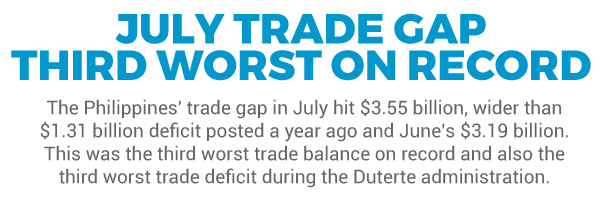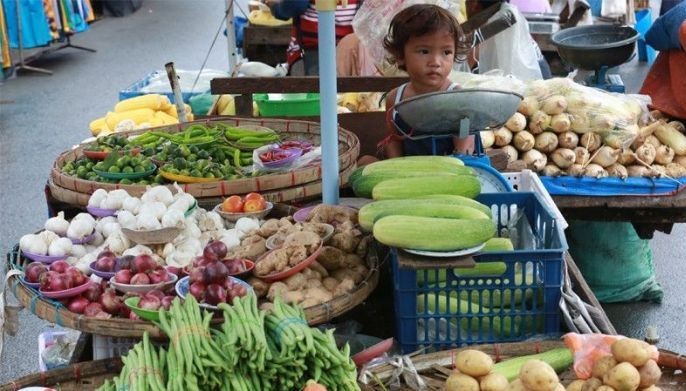Philippine trade gap widens in July amid lackluster export growth

MANILA, Philippines (Update 2, 4:19 p.m.) — The Philippines’ trade deficit swelled in July, the government’s statistics agency reported Tuesday, after exports barely grew during the month while imports continued its accelerated growth pace.
Trade gap in July hit $3.55 billion, wider than $1.31 billion deficit posted a year ago and June’s $3.19 billion. The trade deficit in July was the third worst on record and also the third worst trade balance during the Duterte administration.
Total exports grew by measly 0.3 percent year-on-year to $5.85 billion from $5.83 billion. Exports to Japan, a major trading partner, sagged 18.6 percent.
On the other hand, imports accelerated 31.6 percent to $9.40 billion, the fastest rate since June 2016, on the back of heightened purchases of iron and steel, transport equipment and electronic products, among others.
"Domestic demand continues to drive strong import growth which has not been matched by exports," ING Bank N.V. senior economist Nicholas Mapa said. "The weak Philippine peso contributed to the weak trade performance."

Philippine President Rodrigo Duterte’s plan to keep his country’s growth engine humming by spending more than P8 trillion on infrastructure has been fueling demand for imports of construction-related goods.
The increasing capital goods imports due to the infrastructure boom have reversed the country’s current account surplus to a deficit, pressuring the Philippine peso, which depreciated by 5.5 percent in July.
Government spending on infrastructure and other capital outlays hit P84.5 billion in July, up 17.6 percent from June’s P71.9 billion and 74.6 percent higher than P48.4 billion posted a year ago.
“As the global trade situation becomes less encouraging, improving the overall climate for export development becomes all the more indispensable,” Socioeconomic Planning Secretary Ernesto Pernia said in a statement.
“Trade war fears have weighed on business sentiment, and we now see softer global activity. With a resolution unlikely in the short term, the dispute is expected to dampen growth in both economies and drag down growth in the wider global economy,” he added.
The country’s economic managers have repeatedly said the sustained rise in imports will “support domestic economic expansion.”
But in the second quarter of the year, the Philippine economy slowed down to a three-year low of 6 percent as policymakers continue to fight spiraling inflation.
"Recent strong rhetoric from the central bank in response to soaring inflation and to a weakening Philippine peso could help to stem the currency's weakness and prevent the trade gap from widening further," ING Bank's Mapa said.
- Latest
- Trending

























